Lt. (T/Capt.), T.(Thomas) Leigh Simpson
DFC, Australian Flying Corps
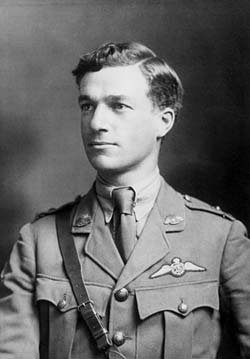
Lt. (T/Capt.), T.(Thomas) Leigh Simpson, DFC, Australian Flying Corps
Hamilton History Center
A 350pixel, 500pixel or 750pixel version of this image may also be downloaded
An alternate set in sepia tone is also available
250pixel, 350pixel, 500pixel or 750pixel
1895 T. (Thomas) Leigh Simpson is born in Hamilton. He, along with his cousin John Robertson Duigan, will fly together in WW1 France as pilots in 3 Squadron of the then fledgling Australian Flying Corps (later the RAAF).
Between them they win a Military Cross (MC), John, and Leigh, a Distinguished Flying Cross (DFC) for bravery under fire. Leigh will also do battle with the infamous Red Baron, Manfred von Richthofen and defying the odds, live to tell the tale...
It's April 21, 1918 and the afternoon sun bathes the fields and towns of Victoria's Western District. Half a world away in Baileul, France its 5am, dark, wet, cold and its war. The groundcrew, pilots and observers of 3 Squadron, Australian Flying Corps are making ready to fly the 'Dawn Patrol'.
Flying RE8s, slow, two seater reconnaissance aircraft they will photograph enemy positions as the German army are forced to retreat towards armistice day, only a few months away.
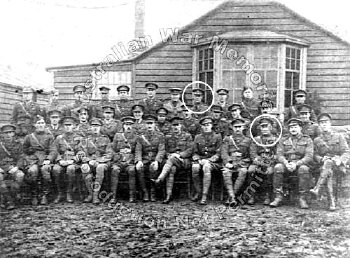
Commanding Officer and Officers of 3 Squadron, AFC
Bailleul, France. November 1917
Lt T. L. Simpson DFC, pilot and Capt J. R. Duigan MC, pilot are circled (L and R respectively)
Back row, L-R: Lieutenant (Lt) G. H. Kindred, pilot; Lt E. C. Banks, observer; Lt A. V. Barrow, observer; Lt S. G. Garrett, pilot; Lt K. C. Hodgson, observer; Lt W. V. Herbert, pilot; Lt F. J. Rae, observer; Lt T. L. Simpson DFC, pilot; Lt C. G. Williams, pilot; Lt S. G. Brearley DFC, pilot; Lt F. J. Tarrant, observer.
Middle row: Lt J. R. Bell, pilot; Lt R. G. D. Francis DFC, pilot; Lt J. L. Sandy, pilot; Lt A. H. McL.Paterson, Lt R. H. Viner, observer; Lt J. Brake, Armament Officer; Lt R. H. Taylor, observer (or ?A. L. D. Taylor); Lt W. A. J. Buckland, observer; Lt C. R. Andrews, pilot; Lt C. E. A. Fossett, pilot.
Front row: Lt E. J. Jones MC DFC, pilot; Lt F. E. Tregilles, pilot; Lt H. N. Wrigley, pilot; Lt R. F. C. Elliott, Brigade Photographic Officer (attached), Imperial Forces; Lt E. G. Knox, Recording Officer; Captain W. H. Anderson DFC, pilot; Major D. V. J. Blake, Squadron Commander; Capt Tait, Intelligence Officer (attached), Imperial Forces; Capt R. S. Brown, pilot, Imperial Forces; Capt J. R. Duigan MC, pilot; Capt R. Ross, Equipment Officer Class 1; Lt E. F. Woods, Equipment Officer (Wireless) Class 2.
Australian War Memorial (AWM) Photograph Database. Negative Number: E02765
A larger image without the white circles may also be downloaded. It will however, still carry the AWM watermark. An image without watermark is available from the AWM.
It has been a hard slog for many of the squadron where many barely had time to unpack before being sent up on their first and often last mission. Today however, the patrol goes well, the photos are taken and no one is lost to enemy fire either from the ground or the air, courtesy of Jasta 11 the squadron led by the now infamous 'Red Baron', Manfred von Richthofen.
It is now about 10.30 am. Lieutenants Simpson and Banks in one aircraft and Garrett and Barrow in a second take off for the next patrol. Within minutes they are attacked by two Fokker Triplanes from Jasta 11 one flown by Hans Weiss the other by none other than the Jasta's leader, Manfred von Richthofen.
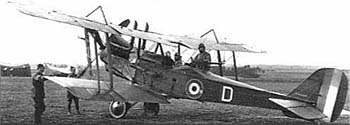
A 3 Squadron RE8, France, c late 1917, early 1918
You may wish to download a 500 pixel version of this image
Through expert flying and the advantage of a rear facing Lewis guns manned by the observers the RE8s are able to fight off Weiss and von Richthofen till help arrives in the form of 'Sopwith Camel' fighters from 209 Squadron RAC led by a Canadian, Captain Roy Brown.
The two Fokkers immediately break off the attack on the RE8s and look for easier pickings. The rest as they say is history. Only minutes later von Richthofen is shot down (most probably by ground fire but oft claimed by Brown)
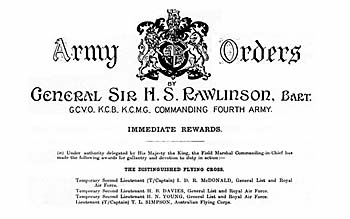
Lt. (T/Capt.), T.(Thomas) Leigh Simpson, DFC, Australian Flying Corps
Hamilton History Center
A
500pixel or
750pixel image may also be downloaded
Before joining the Australian Flying Corps it is noted that Leigh Simpson served in the middle east with 3rd Australian Lighthorse Brigade and more specifically in the 3rd A.L.H. Field Ambulance.
Further research is necessary here but we believe that the following image does indeed show Leigh Simpson during that period and as noted from the AWM image database, immediately after the Battle of Romani in August, 1916.
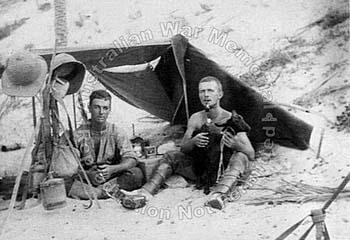
"R Sillett and Leigh Simpson, 3rd A.L.H. Field Ambulance
Photographed in their "shack: just after the Romani Operation 1916-08"
Australian War Memorial Negative No. J02678, Donor Mr R. Sillett
A 500pixel image may also be downloaded
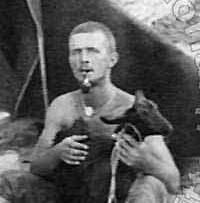
"R Sillett and Leigh Simpson, 3rd A.L.H. Field Ambulance
Photographed in their "shack: just after the Romani Operation 1916-08" (Detail : Leigh Simpson)
Australian War Memorial Negative No. J02678, Donor Mr R. Sillett
Simpson is stated by E.M. Cutlack to have been in the AAMC (Australian Army Medical Corps) prior to duty with 3 Squadron AFC (Australian Flying Corps) in France. Also, the records of the Hamilton History Centre have listed..."SIMPSON Leigh, Lieutenant, 3rd Light Horse Field Ambulance, France, AFC, 3 Squad. WWI"
3rd Light Horse Field Ambulance [Australian Mounted Division]
 3rd Light Horse Field Ambulance [Australian Mounted Division] Formed Queensland 2 October 1914. Departed Brisbane Chilka1 2 February 1915. Assigned to Anzac Mounted Division March 1916. Attached to Imperial Mounted Division February 1917. Assigned to Australian Mounted Division June 1917. Egypt, Gallipoli, Sinai, Palestine 3rd Light Horse Field Ambulance [Australian Mounted Division] Formed Queensland 2 October 1914. Departed Brisbane Chilka1 2 February 1915. Assigned to Anzac Mounted Division March 1916. Attached to Imperial Mounted Division February 1917. Assigned to Australian Mounted Division June 1917. Egypt, Gallipoli, Sinai, Palestine
1 HMAT Chilka, 3,952 tons. 14 knots. British India SN Co. Ltd., London. Commonwealth control ended 4 August 1915
Research at thw AWM also shows only one T.(Thomas) Leigh Simpson on active service with the Australian armed forces in WW1

Australian War Memorial Data for Lt. Thomas Leigh Simpson
A 1000pixel image may also be downloaded
Further Reading
The Australian Light Horse
Anzac Mounted Division
http://bluedog.apana.org.au/~hawkeye/Anzac_Mounted_Division.html
The Anzac Mounted Division was formed in Egypt in March 1916 from the four Australian and New Zealand mounted brigades assigned to ANZAC. These brigades had fought at Gallipoli as infantry
Australian Light Horse
http://www.ar.com.au/~ktroop
K Troop is a Ceremonial mounted troop located in Sydney Australia. K Troop was formed in 1891 as the Parramatta Troop of the New South Wales Lancers
Australian Light Horse Association
http://www.lighthorse.org.au
This site contains both historical and current information on famous regiments, famous battles, both ordinary soldiers and commanders, existing Military Units, current Re-enactment Troops, and Light Horse Museums.
Australians of Arabia and Lawrence
http://www.geocities.com/CapitolHill/Senate/3541/gaoaltit.html
Australian Liberators of Palestine '1916-'1918; (No Australian Lighthorse '1918 - No Israel '1948)
Australian Mounted Division
http://bluedog.apana.org.au/~hawkeye/Australian_Mounted_Division.html
The Australian Mounted Division was formed in Egypt as the Imperial Mounted Division in February 1917 from the 3rd Light Horse Brigade of the Anzac Mounted Division, the 4th Light Horse Brigade, and two british mounted brigades.
Chauvel Collection
http://www.archivenet.gov.au/nfsa/shop/chauvel.htm
An epic tale of the Australian Light Horse and their campaign in the deserts of Sinai during World War I. The Aussie 'digger' was immortalised in this film by Chips Rafferty, who brought to his performance a characteristic irreverence and a laconic sense of humour.
Mounted Troops
http://www.adfa.edu.au/~rmallett/Light_Horse.html
No units of the AIF are so famous as its mounted infantry arm, the Light Horse. Light horse were a cross between cavalry (troops who fought on horseback) and mounted infantry (troops who used horses only to ride to battle). They fought dismounted, like mounted infantry, but were organised like cavalry, and carried out certain roles such as scouting and screening on horseback. Until 1918 they did not carry swords and so could not function as cavalry, although they sometimes could carry out a mounted action using their bayonets, as at Beersheba in 1917.
The Battle of Romani, Egypt, August 3-4, 1916
http://members.optushome.com.au/pasu/aif/battle_of_romani.htm
http://www.awm.gov.au/atwar/thismonth_aug.html
http://www.lighthorse.org.au/histbatt/batrom.htm
http://212.67.202.71/~johnwhal/timeline/romani.htm
Top | Gallery Home
Tom Thurston's midi version of 'Waltzing Matilda' was sourced from Trenches on the Web by Mike Lavarone
|